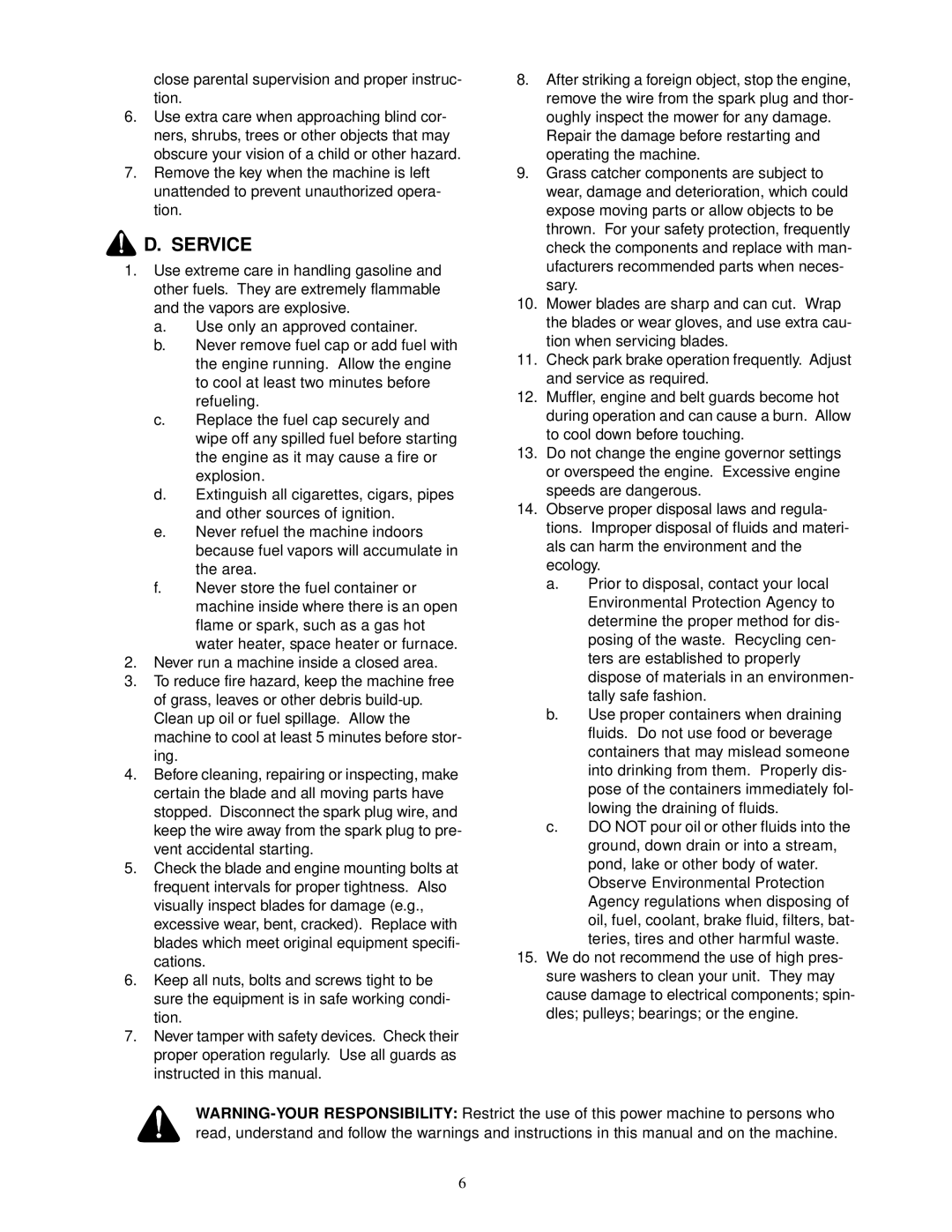
close parental supervision and proper instruc- | 8. | After striking a foreign object, stop the engine, | ||
tion. |
|
| remove the wire from the spark plug and thor- | |
6. Use extra care when approaching blind cor- |
| oughly inspect the mower for any damage. | ||
ners, shrubs, trees or other objects that may |
| Repair the damage before restarting and | ||
obscure your vision of a child or other hazard. |
| operating the machine. | ||
7. Remove the key when the machine is left | 9. | Grass catcher components are subject to | ||
unattended to prevent unauthorized opera- |
| wear, damage and deterioration, which could | ||
tion. |
|
| expose moving parts or allow objects to be | |
D. SERVICE |
| thrown. For your safety protection, frequently | ||
| check the components and replace with man- | |||
1. Use extreme care in handling gasoline and |
| ufacturers recommended parts when neces- | ||
other fuels. They are extremely flammable |
| sary. |
| |
and the vapors are explosive. | 10. | Mower blades are sharp and can cut. Wrap | ||
a. | Use only an approved container. |
| the blades or wear gloves, and use extra cau- | |
b. | Never remove fuel cap or add fuel with |
| tion when servicing blades. | |
| the engine running. Allow the engine | 11. | Check park brake operation frequently. Adjust | |
| to cool at least two minutes before |
| and service as required. | |
| refueling. | 12. | Muffler, engine and belt guards become hot | |
c. | Replace the fuel cap securely and |
| during operation and can cause a burn. Allow | |
| wipe off any spilled fuel before starting |
| to cool down before touching. | |
| the engine as it may cause a fire or | 13. | Do not change the engine governor settings | |
| explosion. |
| or overspeed the engine. Excessive engine | |
d. | Extinguish all cigarettes, cigars, pipes |
| speeds are dangerous. | |
| and other sources of ignition. | 14. | Observe proper disposal laws and regula- | |
e. | Never refuel the machine indoors |
| tions. Improper disposal of fluids and materi- | |
| because fuel vapors will accumulate in |
| als can harm the environment and the | |
| the area. |
| ecology. | |
f. | Never store the fuel container or |
| a. | Prior to disposal, contact your local |
| machine inside where there is an open |
|
| Environmental Protection Agency to |
| flame or spark, such as a gas hot |
|
| determine the proper method for dis- |
| water heater, space heater or furnace. |
|
| posing of the waste. Recycling cen- |
2. Never run a machine inside a closed area. |
|
| ters are established to properly | |
3. To reduce fire hazard, keep the machine free |
|
| dispose of materials in an environmen- | |
of grass, leaves or other debris |
|
| tally safe fashion. | |
Clean up oil or fuel spillage. Allow the |
| b. | Use proper containers when draining | |
machine to cool at least 5 minutes before stor- |
|
| fluids. Do not use food or beverage | |
ing. |
|
|
| containers that may mislead someone |
4. Before cleaning, repairing or inspecting, make |
|
| into drinking from them. Properly dis- | |
certain the blade and all moving parts have |
|
| pose of the containers immediately fol- | |
stopped. Disconnect the spark plug wire, and |
|
| lowing the draining of fluids. | |
keep the wire away from the spark plug to pre- |
| c. | DO NOT pour oil or other fluids into the | |
vent accidental starting. |
|
| ground, down drain or into a stream, | |
5. Check the blade and engine mounting bolts at |
|
| pond, lake or other body of water. | |
frequent intervals for proper tightness. Also |
|
| Observe Environmental Protection | |
visually inspect blades for damage (e.g., |
|
| Agency regulations when disposing of | |
excessive wear, bent, cracked). Replace with |
|
| oil, fuel, coolant, brake fluid, filters, bat- | |
blades which meet original equipment specifi- |
|
| teries, tires and other harmful waste. | |
cations. | 15. | We do not recommend the use of high pres- | ||
6. Keep all nuts, bolts and screws tight to be |
| sure washers to clean your unit. They may | ||
sure the equipment is in safe working condi- |
| cause damage to electrical components; spin- | ||
tion. |
|
| dles; pulleys; bearings; or the engine. | |
7.Never tamper with safety devices. Check their proper operation regularly. Use all guards as instructed in this manual.
6
